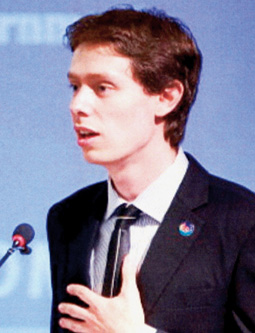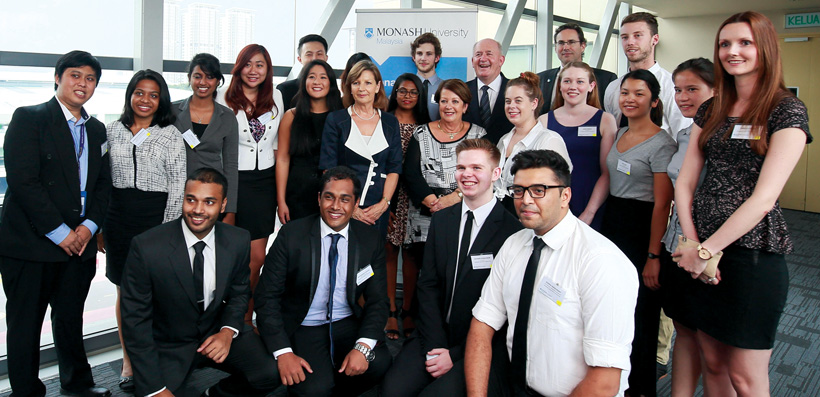Chapter 3
Building Intellectual Capital
Research and development in the sciences
In 1985, the Governments of Australia and Malaysia signed an MOU on Scientific and Technological Cooperation and have since cooperated on a wide range of research partnerships across a number of sectors that include medicine, engineering, computer science, agricultural and biological sciences. The intervening years have seen a broad spectrum of cooperative frameworks functioning on both a bilateral and multilateral basis and many remain ongoing. For example, in 1998, the Australian Academy of Science and the Australian Academy of Technological Science and Engineering signed a joint MOU with the Academy of Science Malaysia. In 2012, scientists from the Australian Nuclear Science and Technology Organisation (ANSTO) started work on a project in Kajang, Malaysia, on the problem of chronic levels of air pollution common in some of Asia's largest cities. ANSTO contributes to several regional programs and joined this project under a Regional Cooperative Agreement (RCA)21 and Forum for Nuclear Cooperation in Asia (FNCA) program.22
The Commonwealth Scientific and Industrial Research Organisation (CSIRO) has also worked closely with Malaysian institutions in a number of areas. In 1998, the CSIRO and Universiti Putra Malaysia signed Letters of Agreement to work on human nutrition, and Relationship Agreements are in place with SCS Computer Systems Sdn Bhd (2000) and the Malaysian Palm Oil Board (2001). In 2003 the CSIRO and PRSB, the research arm of Petronas, entered into an MOU and, in 2007, embarked on a project combining their expertise on petroleum exploration and production, alternative energies, and advanced materials technologies.23 Further collaboration is also underway with the Malaysia–Australia Agricultural Cooperation Working Group (MAACWG) established in 2000. The MAACWG's activities are wide-ranging across agriculture, fisheries, agrifood, sanitary and phytosanitary (SPS) and operational quarantine matters.24 In 2007, at a meeting in Putrajaya, the MAACWG agreed to expand the role of the working group to include forestry, addressing issues such as illegal logging.
My Story

I have aspired to be a New Colombo Plan scholar since the commencement of the program. As a student studying renewable energy engineering and commerce, I saw it as a fantastic opportunity to study in Malaysia; a place where I had travelled in 2014 with university colleagues and had been blown away with a factory tour of a solar cell manufacturing plant. Through the program, I believed I could learn about fascinating new technologies at the University of Malaya, utilise that knowledge by undertaking an internship in the region and through this process, develop international business links.
However, since arriving in Malaysia, I have realised that the New Colombo Plan is about so much more than that! It is also about challenging yourself in a new culture, learning to respect and appreciate that culture and educating others of the Australian culture. It is this acceptance and understanding that breaks down barriers between cultures and fosters a more peaceful and prosperous future for us all.
I have also come to realise that being an ambassador for Australia is not a responsibility, but rather a great privilege. Through seeing the passion the Malaysian people hold for their country and the joy that they have in telling me of the Malaysian culture, I am compelled to share with them what I love about Australia and let them know that they are always welcome in our country. Equally, I find myself regularly telling Australians what they are missing out on if they do not come and visit this beautiful country!
I have now completed an intensely rewarding language course in Bahasa Malaysia. I am looking forward to further practicing this language so that I can form more profound relationships with local students and lecturers. I also look forward to getting involved in extracurricular activities at university, giving me the ability to network with a new student cross-section. The New Colombo Plan experience is set to be my best yet!
Deep connections in the humanities
Research in the humanities is also a rich source of intellectual exchange between our two countries. Monash University has played an important role since the 1960s, led by anthropologists such as Michael Swift, Wendy Smith and Malay literature scholar Cyril Skinner. In 1993, a Centre for Malaysian Studies (CMS) was established at the university and it remains one of only three such centres in the world. At the time it opened, the New Straits Times reported that the CMS signified 'a historical leap forward' in the study of Malaysia in Australia.25 The CMS is affiliated with 18 tertiary institutions across Malaysia and collaborations are multi-disciplinary. Australian academics are among the world's leading Malaysia specialists and many highly respected Malaysian academics retain links to Australian universities. Professor Datuk Shamsul Amri Baharuddin (better known as Shamsul AB), a doctoral graduate from Monash University, is now Director of the Institute of Ethnic Studies at Universiti Kebangsan Malaysia (UKM) and a prolific author on Malay history and culture, and colonial and post-colonial forms of knowledge. He is joined by many other impressive Australia–Malaysia alumni, such as the distinguished educator and author, Professor Jamilah Ariffin, also a Monash graduate, and Professor Prema-chandra Athukorala, a graduate of La Trobe University who is now Professor of Economics at the ANU in Canberra. From its earliest years, ANU has been a home to some of Australia's leading Malaysia specialists. They include economists EK Fisk, Wolfgang Kasper, Heinz Wolfgang Arndt and Hal Hill; historians Emily Sadka, William Roff and Anthony Milner; literature specialists Anthony Jones, Virginia Hooker and Ian Proudfoot; and political scientists Harold Crouch and John Funston.

My Story

When my family migrated to Australia, my parents had to give up their successful careers and social network mid-life, in exchange for new jobs and innumerable household chores in an unfamiliar country. They did all this for us, their children and they were always with us, as a family.
We are descendants of native English-speaking professionals, a dynasty of doctors and educationalists, including internationally acclaimed Cambridge-educated physician, Dr Wu Lien-teh, who was nominated for the Nobel Prize in Medicine in 1935. However, because Malaysians were scarce in Melbourne in the 1970s, we were a curiosity. At school, I was once asked by a classmate if Malaysians lived in trees. Many were bewildered that our ancestors spoke English. Most mistakenly assumed our parents owned a Chinese restaurant.
With time, things changed. Through our integration into society, informal cultural exchanges led to a greater understanding between us and our Australian friends. We are now an established family here, and I have a family of my own. I became a fourth generation medical doctor and the first Victorian woman—and first Australian woman of Asian heritage—to be qualified as both a radiologist and nuclear medicine specialist. My connection with Asia has remained strong, and I co-pioneered the Royal Australian and New Zealand College of Radiologists (RANZCR) fellowship program in Asia.
My interest in education is not confined to the medical profession. I have a parallel career in music education. As a teenager I taught piano and played percussion and drums, and for many years sang with a four-part singing group. Our successful education flagship 'Charteris Music School' is a great pride.
As well as accepting public-speaking engagements, I serve on numerous boards and advise the government in various fields. I am also a businessperson with a successful track record. Through all these various roles, I continue to build strategic relations with Malaysia and Asia.
In 2015, I became the first Malaysian-born woman to be awarded Member (AM) of the General Division of the Order of Australia. My previous awards include the Australia Awards (2014) and my induction to the Victorian Women's Honour Roll (2013). I am also proud to represent this country as an Australia Day Ambassador.
Connecting young Australians to Malaysia
Although, traditionally, the higher education sector dominates discussions surrounding international education exchange, there are growing numbers of linkages across Australian and Malaysian primary and secondary schools. Leading the way since the 1990s has been the Asia Education Foundation (AEF), which has developed curriculum content for Years 2 through to 10 to educate Australian children about Malaysia. The curriculum covers English, History, Geography, Science and the Arts, providing links to our respective government websites, and Malaysian films and media outlets, so that young Australians can develop a sound understanding of their Malaysian neighbours.26 The AEF has also worked extensively with the AMI on several initiatives that bring Australian and Malaysian school educators together.
In 2012, the 'Malaysia Unplugged' program took five Australian school principals and ten teaching staff to Kuala Lumpur and Sarawak and, in 2015, the Australia Malaysia BRIDGE Project was launched. Under this program, eight Australian and eight Malaysian teachers spent time in Kuala Lumpur and Perth in April and May, respectively, to strengthen language skills, build cultural understanding and enhance digital teaching capabilities. AEF and the BRIDGE program not only bring teachers and students together, but work to stimulate deeper cultural learning with a regional focus. In November 2014, for example, the AEF presented a series of workshops on global citizenship and intercultural learning. This took place at the East Asia Regional Council of Schools' (EARCOS) Education Leaders Conference in Kota Kinabalu, which was attended by a range of international schools.